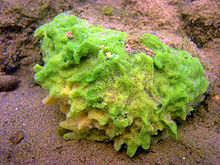
Back سبونجيلا ARZ স্পঞ্জিলা Bengali/Bangla Spongilla Catalan Spongilla CEB Spongilla Spanish Järvekäsn (perekond) Estonian اسفنج آب شیرین Persian Spongilla French Spongilla Dutch Spongilla Swedish
| Spongilla | |
|---|---|

| |
| Spongilla lacustris in the Hanford Reach of the Columbia River, Washington, USA. | |
| Scientific classification | |
| Domain: | Eukaryota |
| Kingdom: | Animalia |
| Phylum: | Porifera |
| Class: | Demospongiae |
| Order: | Spongillida |
| Family: | Spongillidae |
| Genus: | Spongilla Lamarck, 1816[1] |
| Species | |
|
See text | |
| Synonyms | |
| |
Spongilla is a genus of freshwater sponges containing over 200 different species. Spongilla was first publicly recognized in 1696 by Leonard Plukenet and can be found in lakes, ponds and slow streams.[2]Spongilla have a leuconoid body form with a skeleton composed of siliceous spicules. They are sessile organisms, attaching themselves to hard substrate like rocks, logs and sometimes to ground.[3] Using their ostia and osculum these sponges filter the water for various small aquatic organisms such as protozoans, bacteria, and other free-floating pond life.[4] Sponges of the genus Spongilla partake in symbiotic relationships with green algae, zoochlorellae. The symbiotic zoochlorellae give the sponges a green appearance and without them they would appear white.[4]
Spongilla was used by John Hogg in the 19th century to attempt to justify a fourth kingdom of life.[5]
- ^ van Soest, R. (2014). Van Soest RW, Boury-Esnault N, Hooper JN, Rützler K, de Voogd NJ, de Glasby BA, Hajdu E, Pisera AB, Manconi R, Schoenberg C, Janussen D, Tabachnick KR, Klautau M, Picton B, Kelly M, Vacelet J (eds.). "Spongilla Lamarck, 1816". World Porifera database. World Register of Marine Species. Retrieved 2014-05-22.
- ^ Gunther, A (1881). The Annals and Magazine of natural history, zoology, botany, and geology. London Taylor and Francis, Ltd.
- ^ Brusca, Richard C. (2016). Invertebrates (3rd ed.). Sunderland, MA: Sinauer Associates. p. 222. ISBN 9781605353753.
- ^ a b Skelton, J; Strand, M (2013). "Trophic ecology of a freshwater sponge ( Spongilla lacustris) revealed by stable isotope analysis". Hydrobiologia. 709 (1): 227–235. doi:10.1007/s10750-013-1452-6 – via ECBHost.
- ^ Hogg, John (1860), "On the distinctions of a plant and an animal and on a fourth kingdom of Nature", Edinb N Phil J (N Ser), 12: 216–225
© MMXXIII Rich X Search. We shall prevail. All rights reserved. Rich X Search